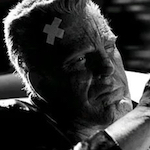 Would you believe Robert Rodriguez & Frank Miller’s SIN CITY had its twentieth anniversary last month? I mean yes it kinda seems like a long time ago, but 20 years ago? That’s a bunch of years. I’m against it.
Would you believe Robert Rodriguez & Frank Miller’s SIN CITY had its twentieth anniversary last month? I mean yes it kinda seems like a long time ago, but 20 years ago? That’s a bunch of years. I’m against it.
(Here’s my review from the time.)
Let’s consider how times were different. Rodriguez was well into his career, having just completed his EL MARIACHI trilogy, with FROM DUSK TILL DAWN, THE FACULTY and three SPY KIDS movies snuggled in between them. He was still in his digital photography evangelist period, ONCE UPON A TIME IN MEXICO having convinced him of how a movie like this could be made affordably at his Troublemaker Studios in Austin. Miramax (before being cancelled) were still surprisingly cool about letting Rodriguez (like Quentin Tarantino) do the type of movies they wanted without much interference. The Ain’t It Cool News (also before being cancelled) were still a player with their breathless reports from Hall H presentations and also sometimes some reviews.
Harry and Moriarty were (it seems to me) the loudest voices promoting the idea of “geek culture” and the potential for great comic book movies if they were made by people who really loved the source material and were faithful to it. Possibly even made for adults.
SIN CITY is the movie that took that idea the most literally. Rodriguez wanted not only Miller’s permission to adapt his interconnected anthology series of noir-inspired crime comics – he wanted him to co-direct it with him. The legendary cartoonist was skeptical, but Rodriguez got him to come shoot a test scene – the opening starring Josh Hartnett (HALLOWEEN H20) as a dreamy stranger who woos a heartbroken woman on the balcony at a party (Mary Shelton, WARRIORS OF VIRTUE) but turns out to be hired to kill her. Miller was hooked and they had footage to show other actors what it would look like. When all was said and done the DGA would only allow one of them to be credited since they weren’t an established team (huh?), so Rodriguez resigned from the guild.
By design the movie is close to a straight up word-for-word, panel-for-panel translation of several Sin City comics stories, so much so that there’s only a “based on” credit, not a “written by.” The comics visually alluded to film noir by being drawn in stark black-and-white, occasionally with spot color (a red dress, a yellow bastard), which led to some colorization gimmicks in the movie version. Much of it was shot on green screen, and a few characters (like Mickey Rourke [DOUBLE TEAM] as Marv) use elaborate latex makeup effects to mimic the way Miller drew them, making this a very stylized world, like a hard-R, digital age DICK TRACY. We’ll get back to that.
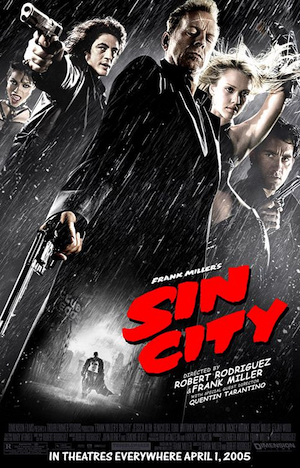 The stories are set in fictional Basin City, an amped up pulp novel hellhole full of macho self-mythologizing criminals, corrupt authorities, and maybe no civilians? The men think in hard boiled narration, waxing worshipfully about “dames” who are goddesses and angels and warriors and valkyries. They reference Lancelot and Galahad and know they’re going to die but think it’s worth it because of the deep love they feel for the woman they spent one night with or the little girl they rescued from a sicko.
The stories are set in fictional Basin City, an amped up pulp novel hellhole full of macho self-mythologizing criminals, corrupt authorities, and maybe no civilians? The men think in hard boiled narration, waxing worshipfully about “dames” who are goddesses and angels and warriors and valkyries. They reference Lancelot and Galahad and know they’re going to die but think it’s worth it because of the deep love they feel for the woman they spent one night with or the little girl they rescued from a sicko.
There’s a built-in anti-establishment attitude and preference for underdog deadbeats as long as they have some street smarts and know how to use a fist or a gun. There’s no justice besides the poetic kind. There’s a child killer who’s the son of a senator, whose brother is a cannibal (and a cardinal). Of the two protagonists who go after them, both are framed for the crimes – one does eight years (then shoots himself), the other gets the chair. Most of the cops are corrupt woman-beaters; one of the three main heroes is a cop who gets tortured by other cops for being “by the book.”
There’s a Titty Twister-esque strip club called Kadie’s Club Pecos, lots of dingy hotels, some docks to meet at of course, some farm land owned by the power brokers, tar pits with dinosaur statues where you hide the bodies, and a red light district called Old Town that’s run by deadly warrior prostitutes (one of them an actual ninja). Pretty cool little neighborhood.
![]() One of the stories, split into two parts, stars Bruce Motherfuckin Willis (NORTH) as Detective John Hartigan, who manages to pull off the old timey trenchcoat look, and has a cool facial scar. In the first part he rescues eleven year old Nancy Callahan (Makenzie Vega, SAW) from a serial killer (Nick Stahl, DISTURBING BEHAVIOR), and shoots the latter’s dick off. Trouble is he’s Roark Junior, son of Senator Roark (Powers Boothe, RAPID FIRE), so Hartigan’s corrupt partner Bob (Michael Madsen) shoots him and frames him for Junior’s crimes. In jail he gets weekly letters from Nancy until they stop and it’s implied she’s been hurt, so when he gets out on parole he goes looking for her.
One of the stories, split into two parts, stars Bruce Motherfuckin Willis (NORTH) as Detective John Hartigan, who manages to pull off the old timey trenchcoat look, and has a cool facial scar. In the first part he rescues eleven year old Nancy Callahan (Makenzie Vega, SAW) from a serial killer (Nick Stahl, DISTURBING BEHAVIOR), and shoots the latter’s dick off. Trouble is he’s Roark Junior, son of Senator Roark (Powers Boothe, RAPID FIRE), so Hartigan’s corrupt partner Bob (Michael Madsen) shoots him and frames him for Junior’s crimes. In jail he gets weekly letters from Nancy until they stop and it’s implied she’s been hurt, so when he gets out on parole he goes looking for her.
She’s now Jessica Alba (IDLE HANDS), and he finds her dancing dressed as a cowgirl at the aforementioned strip club, but he’s followed by Junior, whose injuries turned him into a bizarre monster with yellow skin (and, we later find out, blood).
This story seemed the most deranged at the time, moreso now that I’m as old as Willis was (and I think he’s playing older). Hartigan knows Nancy as an 11-year-old victim, then a 19-year-old dancer he describes as “traumatized,” who leaps off the stage directly into kissing him, tells him she loves him.

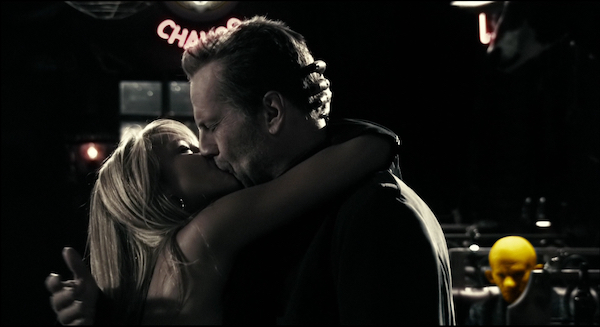
He’s very uncomfortable with her advances and says he could be her grandfather, then gives in to passion for a long kiss, and ends the story saying he loves her. I don’t know, it makes me embarrassed thinking this is supposed to be very honorable and romantic that Hartigan tried to resist a couple times but she kept insisting.
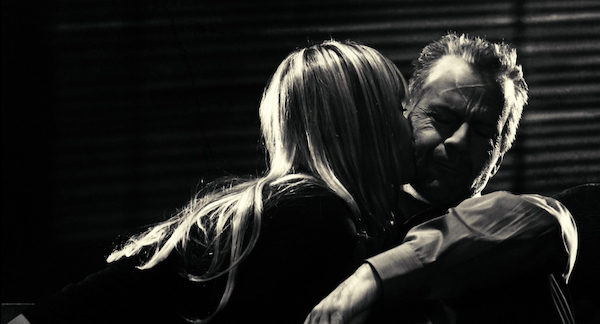
Another story is about Marv, a hulking, ugly lug who has a one-night stand with beautiful Goldie (Jaime King, PRETTY PERSUASION) only to wake up and find her dead, with police outside the motel blaming him for it. The killer is actually Cardinal Roark’s ward Kevin (Elijah Wood, ETERNAL SUNSHINE OF THE SPOTLESS MIND), a silent dork in glasses (usually depicted as a pure white reflection) and a sweater but with deadly kung fu moves and flesh-slashing fingernails. Things don’t go well for Marv and his spectacular lesbian parole officer/friend Lucille (Carla Gugino, SNAKE EYES) but at least he gets to decapitate Kevin and say some of the toughest last words of all time when they execute him.

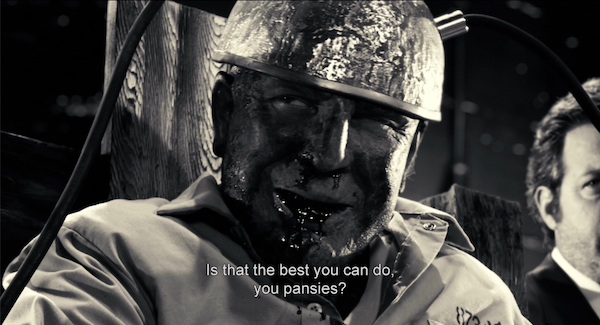
The other main story is about Dwight (Clive Owen, CROUPIER), the most John-Cusack-like of the protagonists. His Kadie’s-waitress girlfriend Shellie (Britney Murphy, DRIVE) is being harassed by abusive ex-boyfriend Jackie Boy (Benicio Del Toro, BASQUIAT) and pals. He follows them to Old Town, where Jackie Boy threatens a young prostitute named Becky (Alexis Bledel right before SISTERHOOD OF THE TRAVELING PANTS) and is killed by resident ninja Miho (Devin Aoki, 2 FAST 2 FURIOUS), and then they find out he was a cop. The ladies of Old Town are led by badass Gail (Rosario Dawson, HE GOT GAME), also a special friend of Dwight, so he helps try to cover up the murder to preserve the truce between Old Town and the pigs. This involves fighting over Jackie Boy’s severed head with ex-IRA mercenaries, and sometimes he imagines the head talking to him. The scene in the car is “guest directed” by Tarantino, but it’s not his best work.
It’s funny that the opening scene was the proof of concept that got Miller and some of the cast on board, because it does look good (except for the silhouettes) but it’s a different view of the city, a different world, elegant rich people shit, not sleazy. It feels a little out of place as an introduction, but pays off at the very end when Becky, who betrayed Gale and friends, gets into an elevator with Hartnett and we know that means she’s reached the end of her story.
There’s plenty to like or even love about this oddball endeavor. We maybe take this for granted now, but it’s a hell of an ensemble cast of the type Rodriguez and Tarantino had made their trademark. Rodriguez had already worked with Rourke, Hartnett, Gugino and Wood. Bruce and Madsen had of course been QT’s guys, but Rodriguez got Dawson and Shelton before DEATH PROOF. In fact, you could include Rourke in that list too, since he was cast as Stuntman Mike before dropping out. I always thought Rodriguez deserved some credit for Rourke’s comeback – ONCE UPON A TIME IN MEXICO and this really showcased his charms at a time when he’d been somewhat floundering, a few years before THE WRESTLER. But I guess Tony Scott using him in MAN ON FIRE and DOMINO could’ve been most of it, I don’t know.
I remember I saw SIN CITY twice in the theater. I really liked it but also had real problems with it. That persists but it’s also aged worse than I thought it would, and the Marv makeup is a major factor. It was an interestingly audacious thing to do, trying to turn a man into a drawing, but it just looks goofy. He seems less like a real guy than Hellboy (whose first movie came out a year earlier). It was distracting at the time and seems worse to me now. This is also true of the undeniably bold visual style.
Don’t get me wrong, some of it looks beautifully artificial. I’ve used some screengrabs here that I think look great. There are only certain parts that look crappy, but they drag it down. You’re trying to fall into this world, trying to leap over the hurdle of stylization to make your mind believe in this place, and then you get a half-assed shot like this.
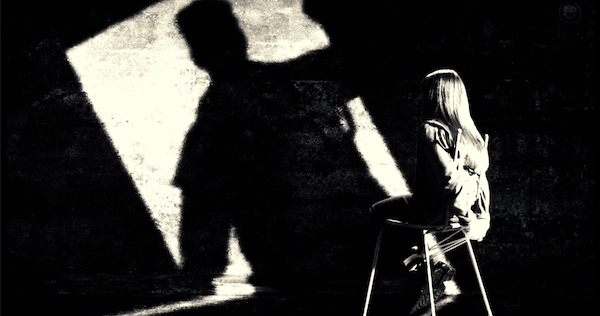
Maybe it was different projected on film, but the opening credits, with comic panels and aggressive typography, now look like a cheesy DVD extra. The phoniness of the green screen car driving is mostly fun and old timey, but sometimes laughable when they switch to CG wide shots where Marv looks like a little Happy Meal toy. There’s a shot where Hartigan pulls up to the docks that I think might be the only on-location shot in the whole movie…

…and it reminds me that god damn, I wish they’d just done this as a gritty black and white movie like BLAST OF SILENCE instead of taking the comic book shit so literally. I still think there’s room for an adaptation of Sin City that involves some adapting. I would love to believe in this place, feel like we’re wandering around in it. When you read the comic books you imagine a real guy in a real place, you don’t imagine a guy who looks like a drawing standing in front of a drawing. In a way it’s too true to the comics to be true to the experience of reading the comics.
Think about the use of white. On the page it’s negative space – it’s the page itself. In a movie it’s light. It moves and remains pure white so it appears illuminated. Honestly I like the gimmick: bandages, jewelry, even blood that glow white. It looks pretty cool, but it’s a totally different thing.
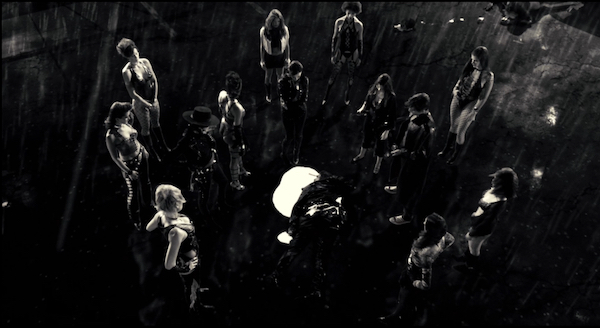
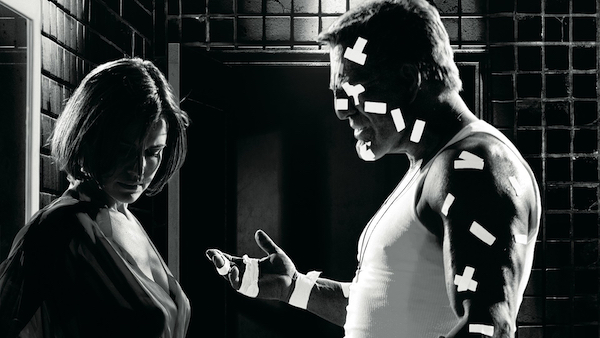
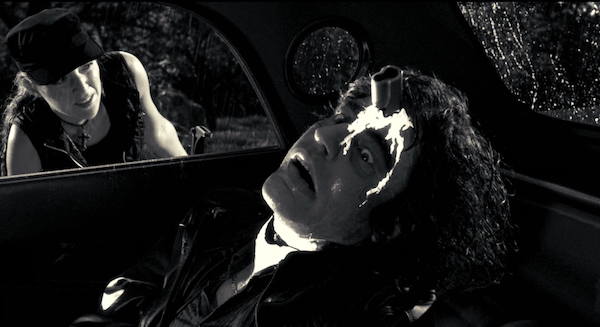
Let me ask you this. Did Marv become tiny here, or does he just have massive novelty sized blinds in his hotel room?
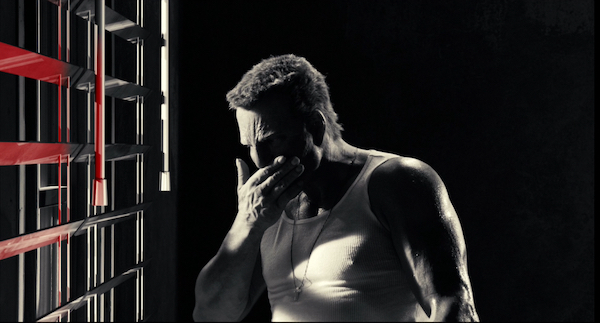
It’s funny, in those days movies were timid about using comic book visual cliches. Most super hero movies switched any colorful lycra to armor or black leather. There were widely held assumptions, even by the “geeks,” about “Oh jesus, you can’t do that in live action, you’d be laughed off the screen.” Sin City didn’t seem to have that issue, the risk it took was being one of the small subset of comic book movies glorying in sex and violence. But because Rodriguez and Miller did such an exact translation of the books – drawn by a veteran super hero guy in the style he’d developed – it does end up having some of those tropes. The dudes all have trenchcoats that blow around like Batman’s cape, they drop off buildings and glide in Batman-swinging-on-a-bathook poses, land crouched in Batman poses. They perch on ledges of buildings, look up to giant statues in the rain, look to the sky in anguish clutching dead loved ones. Also because Miller likes drawing the bottoms of Chuck Taylors we get a couple characters wearing them, and since they gotta distinguish some of these coats they made Dwight’s leather, and let me tell you, a leather duster with red Converse does not look as cool on Clive Owen as it might in a drawing.
Is all this adorable, or misguided? I don’t know. Like the comics that inspired it it’s just such an unlikely mix of artistry and adolescent boneheadedness that you can’t deny its novelty. Sometimes I can get into the spirit of it. I always loved Murphy’s little part in this, especially the old timey way she said “Dwight, ya fool… ya damn fool.” She knew how to talk in this, how to smile, how to lean out the window.

Intellectually I feel like I should respect a movie being so fearlessly dedicated to its visual fetishes, to creating its own artificial world, like POPEYE, DICK TRACY, THE FLINTSTONES, SPEED RACER or BARBIE. And yeah, there are some film-noir-by-way-of-comic-book-by-way-of-restaging-in-Rodriguez’s-studio shots that look fuckin cool.

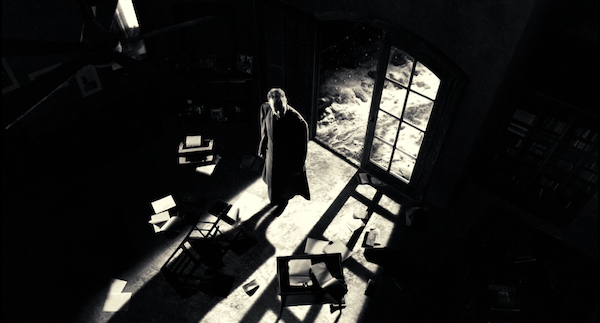
But I don’t know, man. On this viewing it felt like much of it was too distancing, made the whole thing too much of a put-on. Maybe it’s also me growing out of the whole Frank Miller voice. The exaggerated machismo, the free basing of old timey crime movie aesthetics, the simultaneously empowering and misogynistic portrayal of women (think of the lusty awe in Dwight’s voice repeating “deadly little Miho”) – these are all intentional and I do not entirely disavow their appeal, but they feel more hollow and forced to me than they once did.
When Miller made this movie he was slightly younger than I am now. When he made That Yellow Bastard in comics form he was still in his thirties. When he made The Dark Knight Returns he was still in his twenties. So now it seems kind of funny to me that he was so into old guys stumbling and pounding their chests and trying to walk off massive heart attacks because they’re so intent on giving a guy a knuckle sandwich. He just thought it was such a cool thing to imagine doing when you’re aging – being so manly you can scratch out a win against your own frailty.
I’m no Hartigan. I’m pretty healthy and still think of myself as young, cool(ish), not a grown up. Every time I get a hair cut I see the pile of clippings and remember that I’m greyer than I think. But I do have days every once in a while when I have some weird sensation and start thinking “Is this a heart attack? Is this a stroke? Is somebody gonna find me on the floor?” I guess the romanticization of chest pains and downing a jar of “heart pills” like a shot of whiskey seems sillier after that.
Some things haven’t changed, though, including my overall assessment of SIN CITY from 20 years ago: “What this is is a very ballsy and ridiculous experiment, like Gus Van Sant’s PSYCHO. Like most experiments in science, it’s a big failure. But you gotta fuck up in order to invent cancer or whatever. I’m glad these guys did it anyway even though it really doesn’t work.”
So the question is what, if anything, did this important research lay the groundwork for? Would IRON MAN have made it to the screen without movies like this proving the power of the so-called geek community, showing up to this way more niche comic nerd shit? Maybe, maybe not. A more important question might be where such movies would have ended up without this test case of taking the things way too god damn literally. Maybe SIN CITY shifted the Overton window of comic book adaptation far enough that they could find today’s happy medium, not trying to exactly re-create each panel, but generally being true to the spirit of the thing.
Now that I look at it this it’s a pretty interesting time, this mid-aughts period. Film was beginning to transition to digital, opening up possibilities for larks like this. The now dominant super hero genre was still finding its form, some veteran directors were trying out new styles, and popular music and television were absolutely terrible, because I was turning 30. With more curiosity than nostalgia I’ve chosen 2005 as the subject of my summer movie retrospective this year, starting tomorrow with one of the May releases. I don’t have grand plans for this one, it will be a somewhat loose and slapdash affair, but hopefully kind of fun, like the higher end of Robert Rodriguez getting some celebrity friends to come over, put on costumes and shoot some stuff real quick.
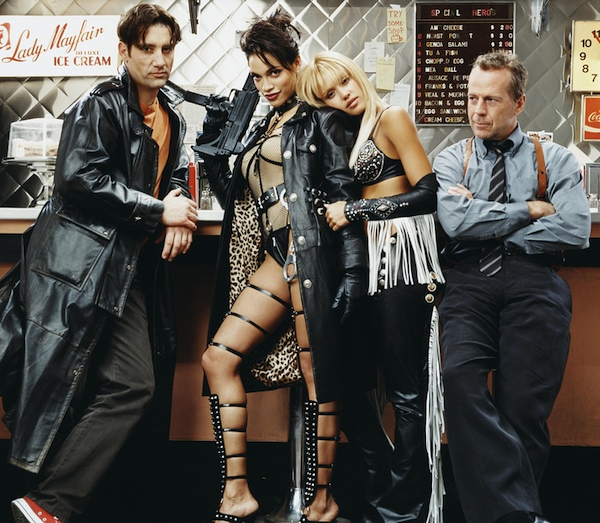
P.S.
Other 2005 comic book movies: FANTASTIC FOUR, ELEKTRA, A HISTORY OF VIOLENCE, CONSTANTINE, V FOR VENDETTA, BATMAN BEGINS


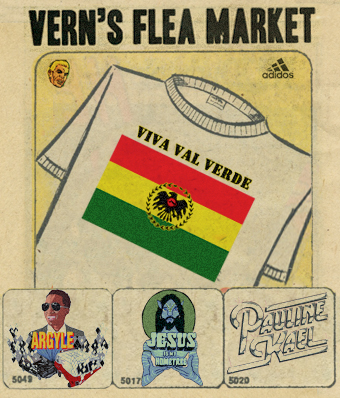
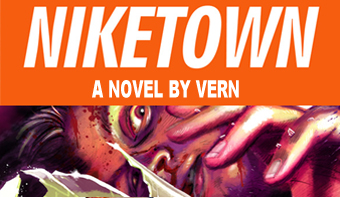

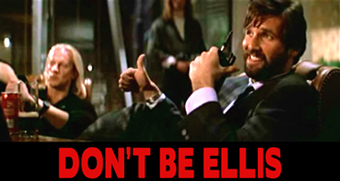










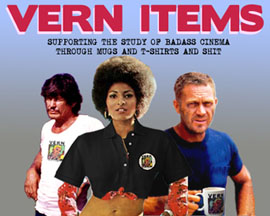
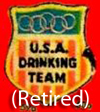
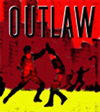







May 15th, 2025 at 2:01 pm
Something must’ve been in the air, because the movie was on my mind recently and I was planning a rewatch. ONe thing that recently dawned on me though without having seen it in at least 10 years, is that it might be the closest thing to another HEAVY METAL than we ever got. HEAVY METAL 2000 failed to recreate the feeling of the 80s movie, while SIN CITY is a similar venn diagram between proud low-brow entertainment that might cross certain lines, but wants you to have fun with it instead of trying to make you leave the room offended and traumatized, a certain niche appeal with “underground” credibility, while also being a star-filled major motion picture. And just like HEAVY METAL it was for a while the coolest shit ever, before it became oddly irrelevant.
Oof, a 2005 retrospective? I’m absolutely on board, but better prepare myself to mentally buckle up. 2005 was more or less “The beginning of the end” for me. At one hand everything seemed good, but on the other hand the cracks started to show and ever since then I’ve been stuck in a place that seems to be impossible to escape, no matter how hard I try. Oh well. I’m gonna focus on the movies this time and look absolutely forward to the nostalgia ride.